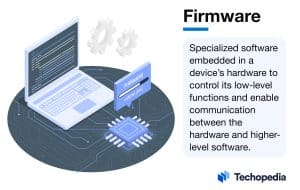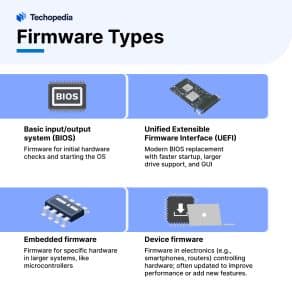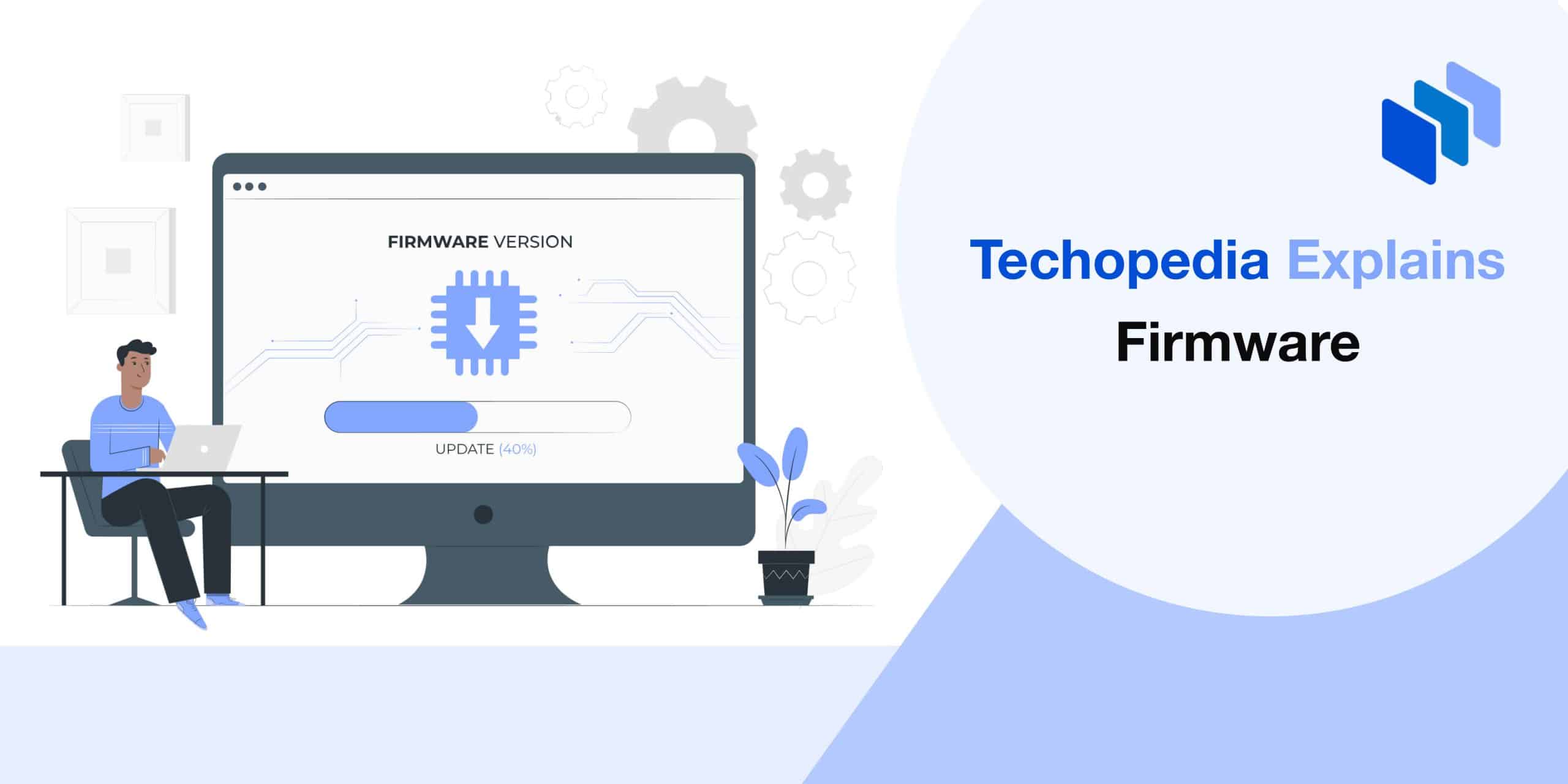What is Firmware?
The simple firmware definition is a type of software embedded directly into the hardware, providing low-level control for the device. Unlike regular software, which can be easily modified or replaced, firmware is stored in a device’s read-only memory or flash memory and usually remains unchanged unless updated by the manufacturer.
Firmware acts as the intermediary between the hardware and higher-level software, ensuring devices operate correctly from the moment they are powered on.
Firmware initializes hardware components, manages system resources, and provides the instructions for hardware tasks. In a computer, the firmware (often known as the BIOS or UEFI) runs the initial checks and configurations required to start the operating system (OS).

Key Takeaways
- Firmware is embedded software that provides low-level control for a device’s hardware.
- Firmware updates are important for security, performance improvements, bug fixes, and adding new features.
- Different types include BIOS, UEFI, embedded firmware, and device firmware.
- Firmware is closely tied to hardware and is less frequently updated, while software runs on top of the operating system and is regularly updated.
- Firmware is found in devices like PCs, routers, smartphones, and IoT devices, playing a major role in consumer electronics, automotive systems, industrial equipment, and medical devices.
Key Components of Firmware Architecture
Firmware architecture consists of several key components that work together to ensure a device operates correctly. Here are the main elements:
ROM is a type of non-volatile memory that permanently stores firmware. It retains its contents even when the device is powered off, ensuring that the essential instructions needed to start and operate the device are always available.
The boot loader is a small program stored in the ROM that initializes the hardware and loads the main firmware code. It runs immediately when the device is powered on, performing initial checks and preparing the system to run the main firmware.
The firmware code is the main set of instructions that control the device’s hardware. It includes the necessary logic and commands for the device to perform its specific functions. This code interacts directly with the hardware components to execute tasks.
The hardware abstraction layer (HAL) is a layer of code that allows the firmware to interact with the hardware components in a standardized way. HAL provides a consistent interface for the hardware, making it easier to write and maintain firmware by isolating hardware-specific details from the main firmware code.
Types of Firmware

There are a few different types of firmware. Here are the main categories:
Why are Firmware Updates Important?
Firmware updates are important for maintaining the security, performance, and functionality of electronic devices. They often include security patches that fix vulnerabilities, protect devices from potential threats, and ensure data safety. Updates can also optimize how hardware and software interact, leading to better performance.
Beyond security and performance, firmware updates address and correct bugs that may cause devices to malfunction or behave unexpectedly. Manufacturers may also add new features or improve existing ones through firmware updates.
Firmware vs. Software
Firmware is a type of software, but software isn’t firmware.
Below are the main differences between the two:
| Aspect | Firmware | Software |
| Definition | Embedded software that provides low-level control for a device’s hardware. | Programs and applications that run on top of the operating system. |
| Function | Initializes and manages hardware components. | Performs various tasks and functions for the user. |
| Update Frequency | Infrequently updated, often only by the manufacturer. | Regularly updated, often by the user or automatically by the system. |
| Dependency on Hardware | Closely tied to specific hardware, essential for device operation. | Runs on a wide range of hardware, less dependent on specific hardware. |
Firmware Examples
Firmware is used in many everyday devices so that they function correctly. Here are some real-world examples:
Firmware Use Cases
Firmware is not only important, but necessary in various fields. Here are some examples:
- Consumer Electronics: Firmware controls the functionality of devices like smartphones, tablets, and smart TVs, managing hardware components and allowing operation.
- Automotive Systems: Modern cars rely on firmware for functions such as engine control, infotainment systems, and advanced driver-assistance systems (ADAS).
- Industrial Equipment: In industrial settings, firmware manages machinery and equipment, providing precise control and monitoring for tasks such as manufacturing, assembly, and automation.
- Medical Devices: Medical equipment like MRI machines, pacemakers, and infusion pumps use firmware to perform important functions.
Firmware Pros and Cons
Like anything, there are benefits and potential drawbacks with firmware.
Pros
- Firmware provides direct control over hardware components, allowing for precise and efficient operation
- Since firmware is less frequently updated, it offers a stable and consistent environment for the device to operate
- Firmware is optimized for specific hardware, ensuring high performance and reliability
Cons
- Updating firmware can be complex and often requires specific tools or procedures, sometimes needing professional assistance
- Outdated firmware can have vulnerabilities that may be exploited, posing security risks to the device.
Firmware Security
Firmware security is important for protecting devices from potential threats. Common vulnerabilities include outdated code and a lack of encryption, which can be exploited by attackers.
Secure firmware development, which involves practices like regular updates, code reviews, and vulnerability testing, is necessary to prevent these risks.
Best practices for maintaining firmware security include:
- Keeping firmware up to date
- Using strong authentication methods
- Ensuring secure communication between devices
The Bottom Line
Firmware is necessary for the proper functioning of modern electronic devices. It acts as the bridge between hardware and software, ensuring that all components work together.
With advancements like UEFI firmware settings, users have more control and flexibility in configuring their systems. Subsystem firmware also plays a major role in specialized components, ensuring they operate efficiently and reliably.
So, what is the firmware meaning? It means your gadgets know what to do when you turn them on.






